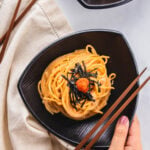Mentaiko Pasta Sauce Recipe
Treat yourself to luxurious Mentaiko Pasta with a creamy sauce that's so delicious and made with only a few ingredients! This recipe is the epitome of proving that a fast meal can be full of flavor! Indulge in a restaurant-quality meal that's sure to impress!
Servings: 2 servings
Calories: 448kcal
Ingredients
Ingredients:
- 8 ounces spaghetti noodles
- 2 tablespoons Japanese mayo
- 2 oz mentaiko* pollock roe or cod roe
- 1/2 tablespoon soy sauce
- 2 tablespoons unsalted butter
- 1 large shallot finely diced
- 2 tablespoons sake
- 1/2 cup dashi stock
- 1/2 cup cream
- 2 tablespoon parmesan cheese grated
Toppings (Optional):
- shredded seaweed for garnish
Instructions
- Boil a large pot of water and cook the spaghetti noodles according to the package's instructions. Drain and set aside.
- In a large bowl heatproof, combine Japanese mayo, mentaiko, and light soy sauce. Set aside.
- Heat medium-sized skillet on medium heat. Melt the butter and add in shallots. Cook until they're soft then add in the sake. Cook until the alcohol has evaporated.
- Pour in the dashi stock and cook until the stock has thickened and reduced by half, stirring occasionally.
- Add the cream and parmesan cheese and cook until the cheese has melted. Reduce the heat if needed so the sauce doesn't come to a boil, otherwise, your sauce may have a grainy texture.
- Transfer the cream sauce to the mentaiko mixture, then toss in cooked noodles. Coat well then serve immediately with shredded seaweed garnished on top, if desired. Enjoy!
Video
Notes
- Noodles: Fresh or frozen udon noodles are a great alternative if you love thick chewy noodles! Just double the noodle weight in the recipe when using pre-cooked noodles (like frozen pre-cooked udon)because dried pasta (like the spaghetti in this recipe) doubles in weight after boiling.
- Japanese Mayo: Japanese mayo is slightly sweeter and creamier - I don't recommend swapping this out because the flavor of the sauce will change! You can easily find it at local Asian markets.
- Mentaiko: Also known as pollock roe or cod roe. I'll admit that it can be a little tricky to find and there isn't a substitution for this recipe since it has a unique flavor. Your best bet would be at local Japanese or Asian markets. They can either be fresh in the fish sac or already packaged.
- Dashi Stock: I highly recommend using dashi stock powder if you can find it at your local Asian markets or Amazon. However, if you have trouble, you can use chicken broth instead.
- Serving / Storing: This dish is best eaten fresh. If you try to reheat it, the fish eggs become overcooked and it changes the flavor of the dish.
Nutrition
Serving: 200g | Calories: 448kcal | Carbohydrates: 46g | Protein: 14g | Fat: 24g | Saturated Fat: 12g | Polyunsaturated Fat: 5g | Monounsaturated Fat: 6g | Trans Fat: 0.2g | Cholesterol: 107mg | Sodium: 338mg | Potassium: 243mg | Fiber: 0.2g | Sugar: 1g | Vitamin A: 682IU | Vitamin C: 3mg | Calcium: 82mg | Iron: 2mg
